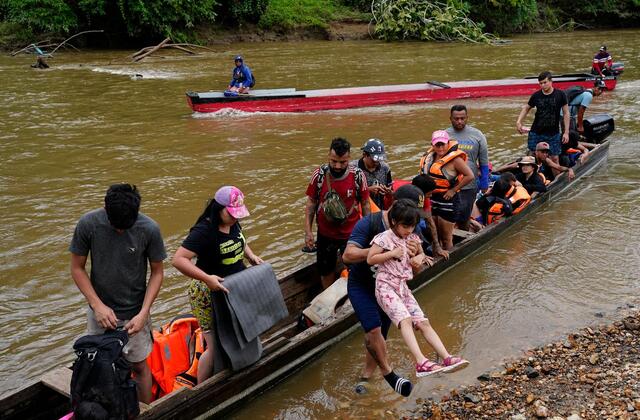
At the edge of Panama’s Darien jungle Friday, Venezuelans made up the majority of migrants waiting for buses to speed them across the country to Costa Rica, where they planned to continue moving north.
Annie Carrillo, a 38-year-old Venezuelan traveling with her Colombian husband and a friend, said they had crossed the dense, lawless jungle from Colombia in three days after paying $350 each to a guide. When she heard about the U.S. government’s plan to restart deportation flights to Venezuela in the coming days, Carrillo was discouraged.
“No one emigrates from their country because they want to. One migrates because you have basic needs and there isn’t support in your native country,” she said, starting to cry.
The U.S. government hopes the threat of deportation will be enough to make Venezuelans reconsider trying to enter the United States illegally and opt instead for the online appointment system to make asylum claims or other legal paths. But some migrants said Friday that it would not stop them from continuing their journey.
Venezuela has suffered political, economic and humanitarian crises over the past decade, pushing at least 7.3 million people to migrate and making food and other necessities unaffordable for those who remain. The vast majority who fled settled in neighboring countries in Latin America, but many began coming to the United States in the last three years.
The U.S. Department of Homeland Security’s assistant secretary for border and immigration policy said Friday that it is already repatriating people to countries with humanitarian situations similar to those in Venezuela.
“These direct repatriations are obviously made now to Venezuela, but also to other countries that have complicated situations such as Haiti, Cuba and other countries around the world,” Blas Núñez-Neto told reporters. “What we are announcing is in accordance with our laws, with our international obligations.”
The U.S. Border Patrol encountered Venezuelans 22,000 times along the southwest border in August, nearly double the number in July, but still slightly below the 25,000 encounters in August 2022. Although Venezuelans make up about 60% of the migrants crossing the Darien Gap this year, they trail migrant numbers from countries including Mexico, Honduras and Guatemala at the U.S. border. At least 16 migrants died and more were injured Friday when a bus carrying them crashed in the southern Mexican state of Oaxaca.
Núñez-Neto said more than 130,000 Venezuelans had arrived to the U.S. in the past year through legal paths, such as CBP One and humanitarian parole.
Still more than 2,500 miles (4,000 kilometers) from the nearest U.S. border crossing, Carrillo hadn’t made up her mind yet about whether they would wait for an appointment to seek asylum or risk crossing and turning themselves over to U.S. border agents. She said they had heard it could take more than three months to get an appointment through CBP One, an eternity for migrants who usually spend all their money just making it to the border.
“What sense is there in making this journey where every second counts and every second you’re putting your life at risk and only to arrive in a country and have them deport you just like that?” Carrillo said.
Patricia Andrade, one of the founders of the humanitarian assistance organization Venezuelan Roots in Miami, was incredulous about the possibility of mass deportations to Venezuela considering that thousands of migrants arrive every day at the southern border.




